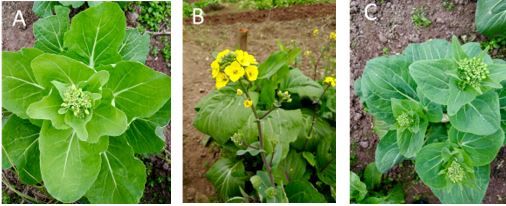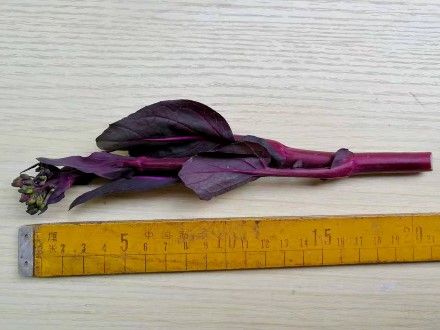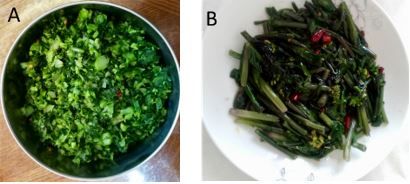Choy sum, also spelled choi sum, is a member of the genus Brassica of the mustard family, Brassicaceae (Brassica rapa var. parachinensis or Brassica chinensis var. parachinensis). This leafy crop is also known as Chinese flowering cabbage. In Mandarin, choy sum is called "caixin" which means "the heart of a cabbage." It has been widely cultivated in southern China for more than 1,000 years and is currently cultivated and consumed by a growing population in the western world. In China, the plants are often harvested during winter, when there are fewer vegetable types available in the market. Although all aboveground plant parts of choy sum are edible, this crop is harvested primarily for the flowering stems that bear leaves during bolting. There are two common cultivars: choy sum (Brassica rapa subsp. chinensis var. parachinensis) (Figure 1A) and purple cai-tai choy sum (Brassica rapa subsp. chinensis var. purpuraria) (Figure 1B) (USDA 2020). The stem and branches of choy sum are light green while the purple cai-tai are purple. The flowering shoots of bok choy (Brassica rapa subsp. chinensis) (Figure 1C) are also sometimes categorized as a type of choy sum (Zhang et al. 2016).

Credit: Qingrong Tang, Kaijiang, Sichuan, China
Description
Choy sum is an herbaceous annual plant and is 8 to 16 inches (20 to 41 cm) tall, depending on genetic and environmental conditions. The roots are shallow and can reach 5 inches (13 cm) in depth and radius in the soil. Flowers initiate when there are seven to eight leaves or when the plant is about 8 inches (20 cm) tall.
Choy sum has alternate leaves with small yellow flowers on the top of each shoot. Every flower has four oval-to-round petals and six stamens. The main stem is about 0.2 to 0.4 inches (0.5 to 1 cm) in diameter at the base and 6 to 8 inches (15 to 20 cm) in height (Figure 2). The leaves are oval, and the color is light to dark green or even purple on some purple cai-tai. It has silique fruit with small, dark, round seeds inside.

Credit: Qingrong Tang, Kaijiang, Sichuan, China
Cultivation
Choy sum is a cool-season crop. Low temperatures (59°F to 77°F or 15°C to 25°C) promote strong stalks and increase sweetness, but only the purple cultivar can tolerate frost (Moore and Morgan 1998). In Florida, choy sum should be grown in mid- to late spring and early autumn to avoid frost. Choy sum adapts to a wide range of soil types but prefers fertile and well-drained soils (Moore and Morgan 1998). It can tolerate moderate water deficit but is susceptible to waterlogging (Chin 1999). Choy sum should be planted in raised beds if waterlogging or heavy rain is a problem. The preferred soil pH range is 6–7 (Moore and Morgan 1998). In sandy soils, the typical plant spacing is 11 inches (28 cm) between rows and 8–12 inches (20–30 cm) between plants (Vavrina 1992). Seeds are planted at the depth of 0.24 inches (0.6 cm) (Moore and Morgan 1998). Transplants are often used for varieties with larger plant size and longer growth period (PlantUse English 2016). Harvest begins 30–50 days (Nguyen 1992) after sowing when the flower buds are fully developed but not open. Leaves, flower buds, and stems are harvested together. There are two to three harvests for each season, and the total yield is 9,800 to 16,000 lb/acre (11–18 t/ha) (Shuler 1995). Larger seeds and appropriate irrigation can improve yield and product quality (Yip et al. 1976). It is vulnerable to inadequate water and nitrogen fertilization (Nobel 2009).
There is no fertilization recommendation available for this new crop, but it belongs to the same family as cabbage. Therefore, Florida growers can use the recommendations for cabbage for the time being: 150, 120 and 100 lb/acre (168, 135, and 112 kg/ha) N phosphate pentoxide for very low, low, and medium P; it is the same rate of potassium oxide input for K (Liu et al. 2019). Irrigation should be once or twice a week based on evapotranspiration from your local weather station (https://fawn.ifas.ufl.edu/; Kamarudin et al. 2014; Khairun et al. 2016).
Choy sum is susceptible to pests and diseases common to the Brassica family. The common insect pests are beet armyworm (Spodoptera exigua) and fall armyworm (Spodoptera frugiperda) in fall, sporadic aphid infestations in winter and early spring, and diamondback moth (DBM, Plutella xylostella) in spring, as well as aphids (Brevicoryne brassicaea), green looper caterpillar (Trichoplusia ni), and white butterfly caterpillar (Pieris brassicae) (Nguyen 1992). Choy sum plants cannot withstand more than 40% volumetric soil water or 300 mm rainfall per month, which will cause bacterial soft rot (Vavrina 1992; DOA 1998; Kamarudin et al. 2014).
Consumption
Choy sum is nutritious and is especially rich in folate (Vitamin B9) (Table 1) (Houlihan et al. 2011) and carotenoid (Wills and Rangga 1996). Like other vegetables of Brassicaceae (Cruciferae) (broccoli, cabbage, spruce sprout, etc.), choy sum also contains high levels of sulfur compounds that can reduce the risk of cardiovascular diseases and some cancers (Lin and Harnly 2010). Antioxidants were almost triple in steamed choy sum compared with raw (Wachtel-Galor et al. 2008).
Consumers often stir-fry choy sum with garlic or dried chili pepper (Figure 3A, B). Choy sum is also used in salads and soups. The shelf life of choy sum can reach up to nine days in ideal conditions (Temperature = 5±1°C, R.H.= 40%–60%) (Chung et al. 2012). It should be consumed as soon as possible to avoid loss of quality, especially the conversion of nitrate to nitrite, which has detrimental effects to human health (Chung et al. 2012).

Credit: Yi Wang, Kaijiang, Sichuan, China
References and Further Reading
Chin, H. F. 1999. Malaysian Vegetables in Colour: A Complete Guide. Kuala Lumpur: Tropical Press. Sdn Bhd
Chung, W. Q., S. H. Ahmad, M. Z. Zamri, and A. B. Rosenani. 2012. "Nitrate and Nitrite Contents and Postharvest Quality of Choy Sum (Brassica rapa chinensis Group) during Storage." Acta Hortic. 1012: 315–320. https://doi.org/10.17660/ActaHortic.2013.1012.39. Accessed January 17, 2024.
DOA (Department of Agriculture). 1998. Package of Technology for Sawi. Kuala Lumpur: DOA.
Houlihan, A., M. Pyke, P. Scheelings, G. Graham, G. Eaglesham, T. O'Hare, L. Wong, P. Puwastien, and W. Jongjitsin. 2011. Folate Content of Asian Vegetables. Project Report. Rural Industries Research and Development Corporation (RIRDC). RIRDC Publication No. 10/167, Project No. PRJ-000044. Canberra, Australia.
Kamarudin, N. K., C. B. S. Teh, and H. Zej. 2014. "Modelling the Growth and Yield of Choy Sum (Brassica chinensis var. parachinensis) to Include the Effects of Nitrogen and Water Stress." Malaysian Journal of Soil Science 18: 1–17.
Khairun, N. K., C. B. S. Teh, and Z. E. J. Hawa. 2016. "Simultaneous Effects of Water and Nitrogen Stress on the Vegetative and Yield Parameters of Choy Sum (Brassica chinensis var. parachinensis)." Pertanika Journal of Tropical Agricultural Science 39 (1): 101–116.
Lin, L. Z., and J. M. Harnly. 2010. "Phenolic Component Profiles of Mustard Greens, Yu Choy, and 15 Other Brassica Vegetables." Journal of Agricultural and Food Chemistry 58 (11): 6850–6857.
Liu, G., E. H. Simonne, K. T. Morgan, G. J. Hochmuth, S. Agehara, and R. Mylavarapu. 2019. Chapter 2. Fertilizer Management for Vegetable Production in Florida. CV296. Gainesville: University of Florida Institute of Food and Agricultural Sciences. https://edis.ifas.ufl.edu/cv296. Accessed January 17, 2024.
Moore, S., and W. Morgan. 1998. "Chinese Flowering Cabbage." The New Rural Industries. Edited by K. W. Hyde, 178–181. Canberra, Rural Industries Research and Development Corporation.
Nguyen, V. Q. 1992. "Growing Asian Vegetables." Agfact, H8.1.37, NSW Agriculture, Australia.
Nobel, P. S. 2009. Physicochemical and Environmental Plant Physiology (4th ed). 420–421. San Diego: Elsevier Academic Press.
NSW Department of Primary Industries. n.d. "Choy sum (Brassica rapa subsp. parachinensis)." https://www.dpi.nsw.gov.au/agriculture/horticulture/vegetables/commodity-growing-guides/asian-vegetables/a-f/choy-sum-em-brassica-rapa-subsp.-parachinensisem. Accessed January 17, 2024.
Shuler, K. D. 1995. "Guidelines for Chinese Leafy and Root Crop Vegetable Production in South Florida." FACTS 1995 Vegetable Crop Proc. Edited by G. J. Hochmuth and D. N. Maynard, 53–57.
USDA, Agricultural Research Service, National Plant Germplasm System. 2020. "Germplasm Resources Information Network (GRIN-Taxonomy)." National Germplasm Resources Laboratory, Beltsville, Maryland. https://npgsweb.ars-grin.gov/gringlobal/taxonomydetail.aspx?id=105454. Accessed January 17, 2024.
Wachtel-Galor, S., K. W. Wong, and I. F. Benzie. 2008. "The Effect of Cooking on Brassica Vegetables." Food Chemistry 110 (3): 706–710.
Wills, R. B., A. W. Wong, F. M. Scriven, and H. Greenfield. 1984. "Nutrient Composition of Chinese Vegetables." Journal of Agricultural and Food Chemistry 32 (2): 413–416.
Wills, R. B. H., and A. Rangga. 1996. "Determination of Carotenoids in Chinese Vegetables." Food Chemistry 56 (4): 451–455.
Yip, S. M., C. S. Pao, T. C. Tong, and Y. S. Ng. 1976. "A Note on Some Studies of Chinese Flowering Cabbage (Brassica parachinensis Bailey)." Agriculture, Hong Kong 1 (5): 407–418.
Zhang, X., T. Liu, X. Li, M. Duan, J. Wang, Y. Qiu, H. Wang, J. Song, and D. Shen. 2016. "Interspecific Hybridization, Polyploidization, and Backcross of Brassica oleracea var. alboglabra with B. rapa var. purpurea Morphologically Recapitulate the Evolution of Brassica Vegetables." Scientific Reports 6: Article Number 18618.